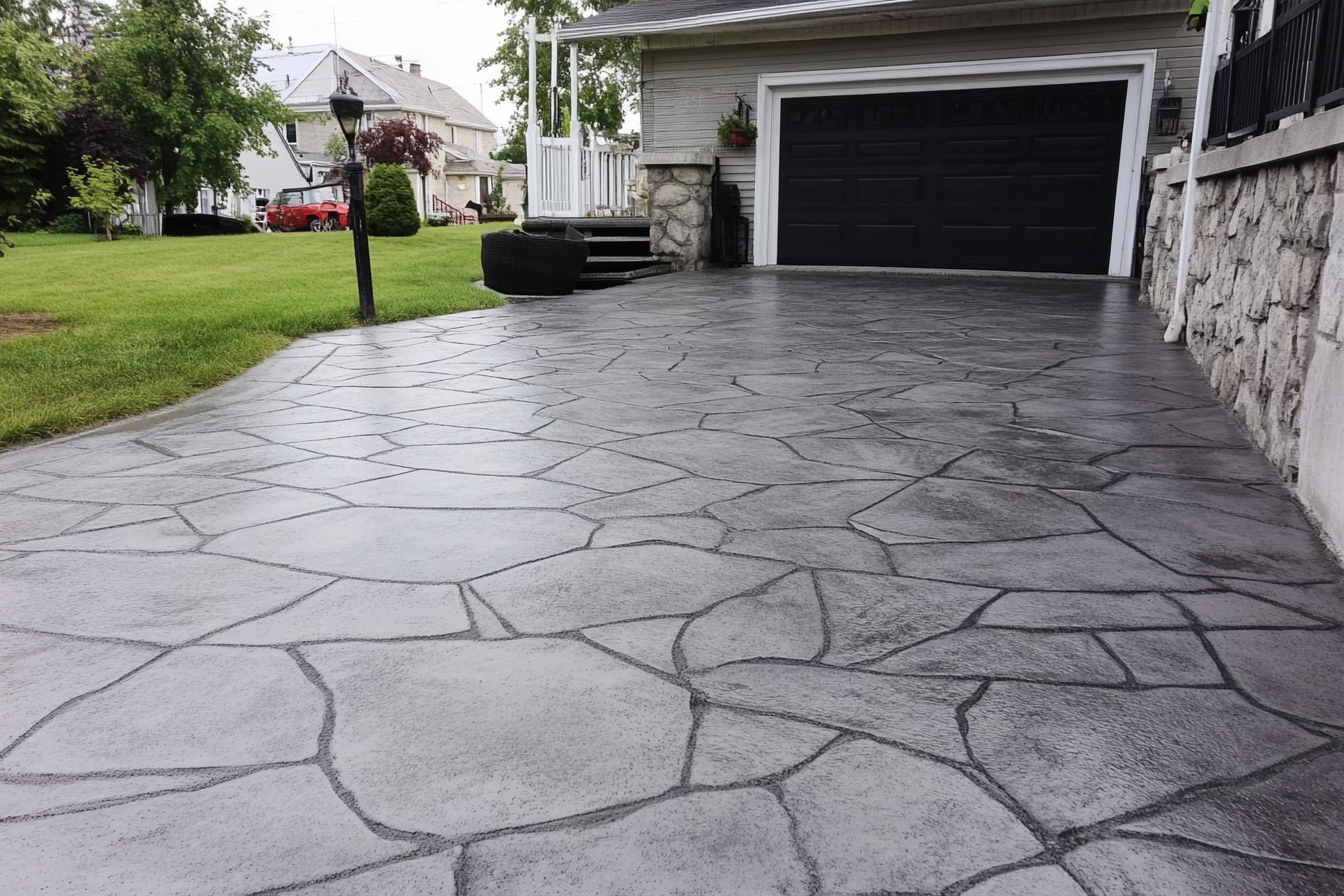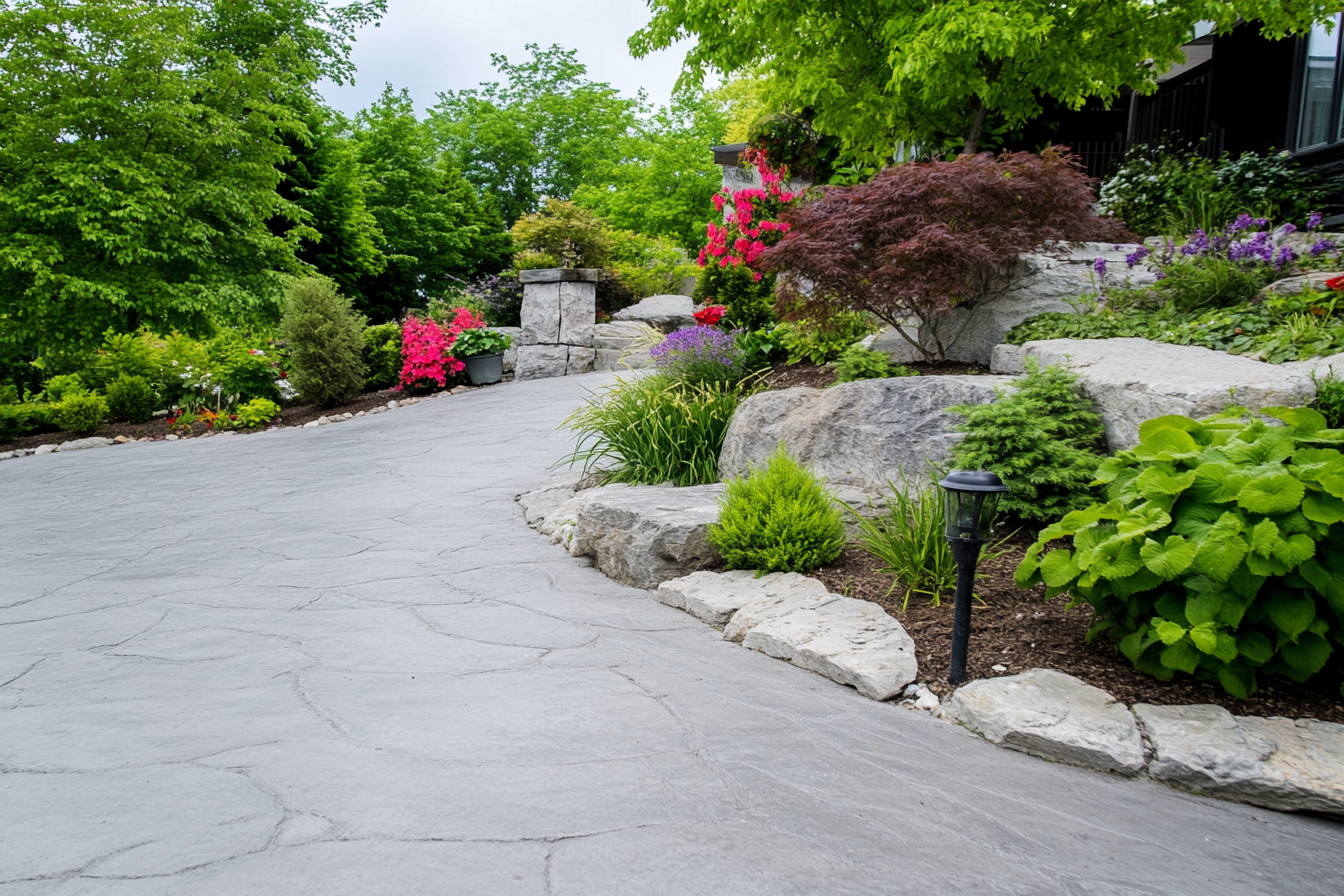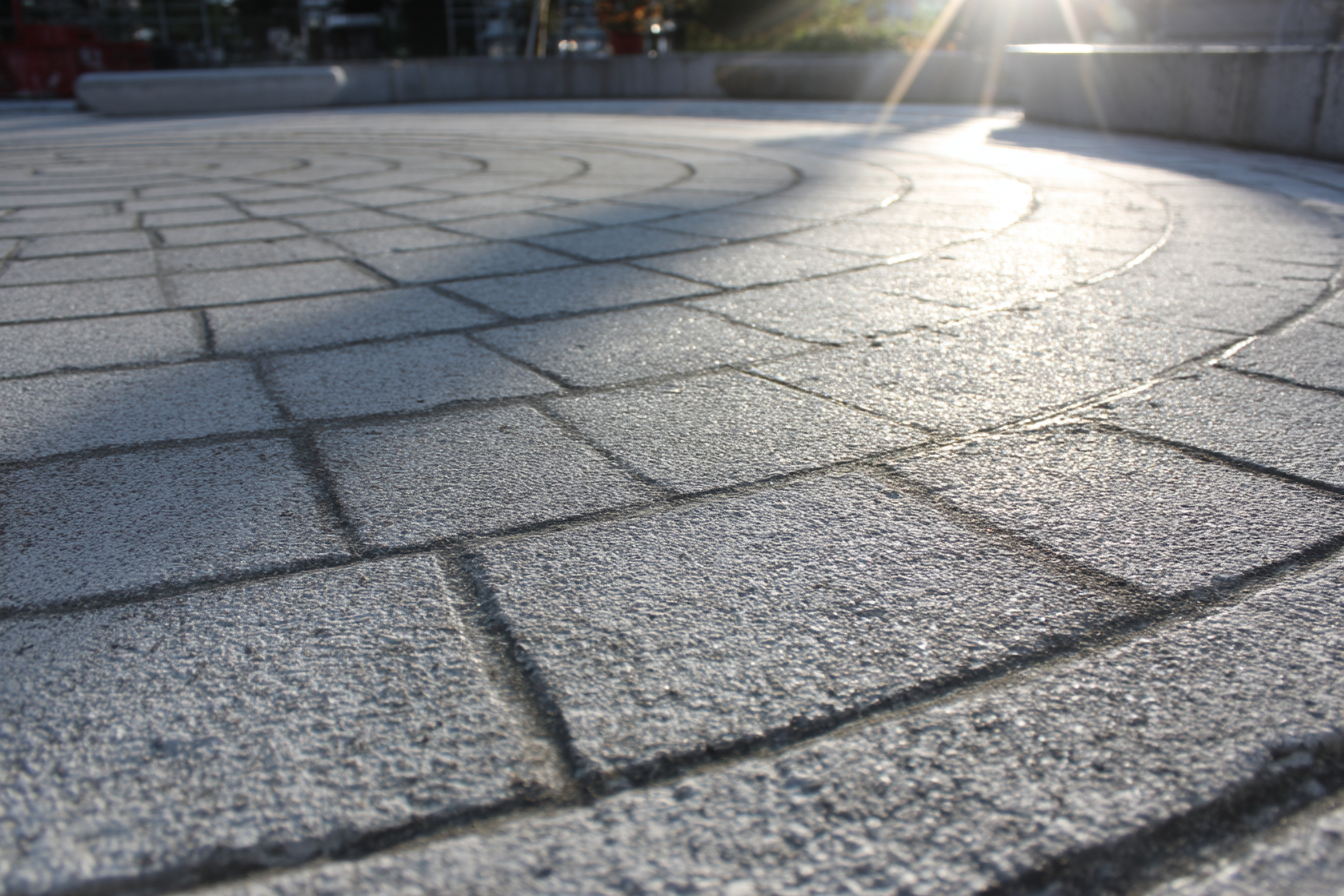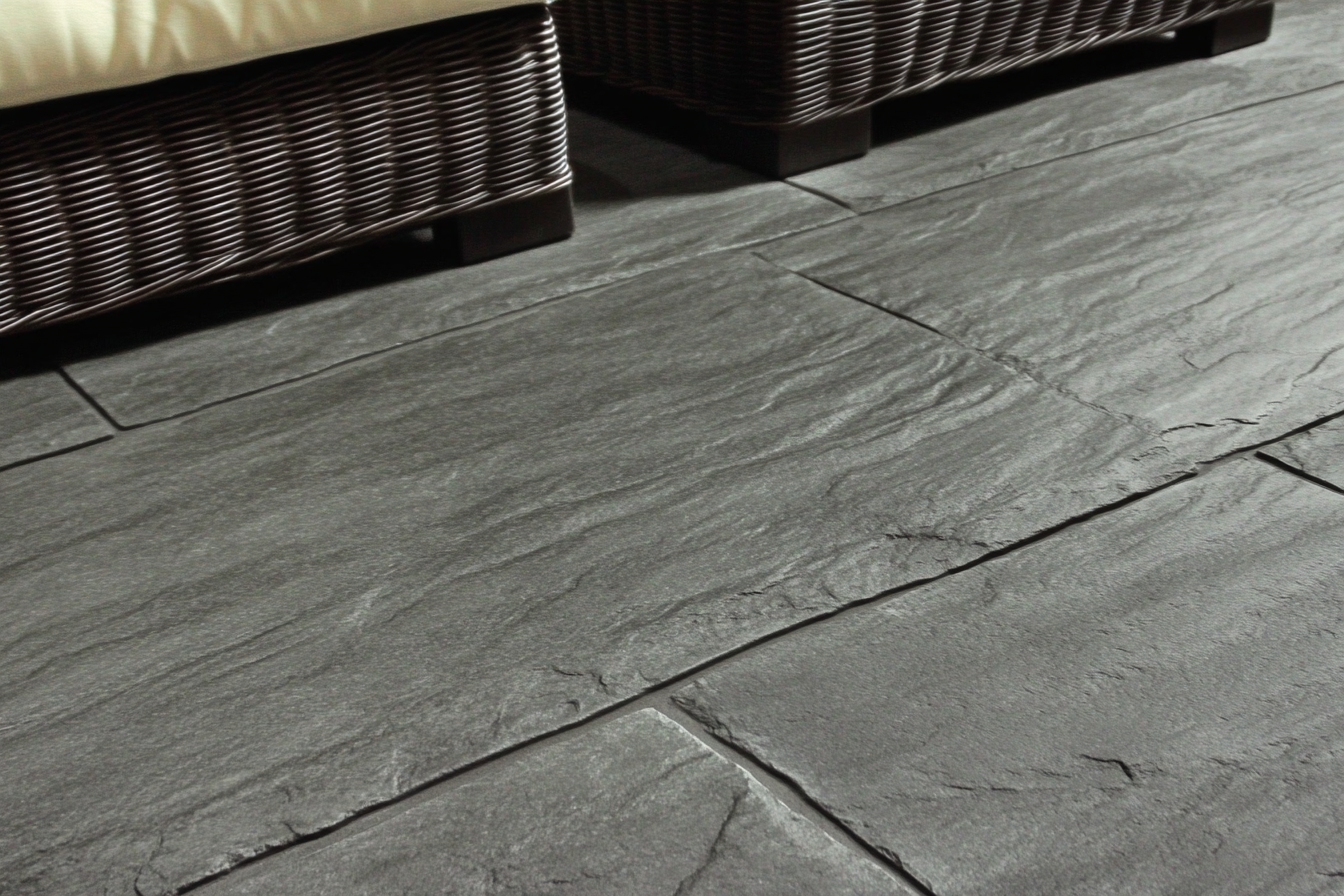
True to its name, stamped concrete combines two things: concrete and stamps. While this definition paints a rather clear picture of what this building material actually is, it’s still important to delve into its other defining factors, thereby taking a closer look at other types of concrete.
What’s stamped concrete?

Source : Soumission Rénovation
Stamped concrete, also known as “textured” or “imprinted” concrete, is a cutting-edge landscaping and building method that has amassed quite a following in recent years.
This type of concrete has an extensive selection of patterns and colours. The method used to make stamped concrete consists of pouring 4-inch to 6-inch thick pre-coloured slabs of cement on-site. Then, rubber moulds are used to imprint designs on the concrete’s surface while the latter is still malleable.
The Advantages of Stamped Concrete
Stamped concrete is low maintenance, elegant, durable, and cost-effective. What’s more, it’s important to note that this material is fire-, insect-, rot-, and mould-resistant. Given the aforementioned qualities, it’s no wonder this material is often used to mimic others like pavers, fieldstones, ceramic tiles, brick, and even wood at times. Fun fact: Concrete is increasingly resistant over time, which is a factor that sets it apart from other types of materials available on the market.
Besides, stamped concrete can be used just about anywhere, whether it’s to revamp the coping around a pool, walkways, balconies, parking lots, stairs, or even patios. That’s proof enough of just how versatile this material is, which is without a doubt one of its greatest assets.
Picking the Right Concrete Type

Source : Soumission Rénovation
Concrete is a paste with varying consistencies that, when cured, becomes solid after having been moulded in a factory or poured directly on-site. There are several types of concrete and what’s referred to as concrete will change based on the type of binder used.
Cement-Based Concrete
Since the 20th century, cement-based concrete has risen in the ranks, sitting in the number two position, and is one of the most used mineral materials in the world. It has also become the most used building material on the planet. Note that in layman’s terms, when speaking of concrete, ultimately, one is referring to cement-based concrete.
Soil-Cement
On the other hand, soil-cement (also known as rammed earth or daub), was primarily used before the 20th century. This type of concrete was clay- and silt-based. And, at the time, these materials were available for free and in large quantities, sourced directly from the ground. Nowadays, soil-cement is still used, but isn’t as sought-after compared to cement-based concrete. Nevertheless, it’s an eco-friendlier option, and its manufacturing method is much simpler too. Clay and silt are free, and the transformation process of rammed earth requires no chemical agents.
How to Clean Stamped Concrete

Source : Soumission Rénovation
Cleaning stamped concrete is rather straightforward and can be done following these key steps.
Regular Cleaning
Stamped concrete has to be regularly cleaned to remove dirt, dust, and debris. Use a soft-bristle broom to remove debris from the surface, then use a garden hose with a moderate-pressure nozzle to rinse the surface.
Use a Cleaner
If your stamped concrete has stubborn stains or oil stains, you might have to use a specially designed cleaner made for concrete surfaces. Make sure to follow the manufacturer’s instructions and test the cleaner on a small, unapparent spot before using it over the entire surface.
Repair Cracks
Regularly inspect your stamped concrete to locate any fissures or damage. If you spot any, use a specially designed repair putty to fill in and seal the gaps. Follow the manufacturer’s instructions and allow for ample drying time prior to walking or driving over it.
Weatherproof
To prolong your stamped concrete’s lifespan, it’s highly recommended to apply a coat of protective sealant every year or every other year. The sealant will safeguard the surface from discoloration, stains, and wear brought on by the elements, such as the sun, rain, and snow. Make sure to choose a sealant made for stamped concrete surfaces.
Say Nay to Corrosive Chemical Products
Avoid using corrosive chemical products, such as salt-based ice melters on stamped concrete, as they can damage the surface. Use salt-free ice melters or more gentle alternatives to prevent damaging the surface.
By following these simple steps and regularly cleaning the surface, your stamped concrete will withstand the test of time and still look good.
How much does a stamped concrete structure cost?

Source : Soumission Rénovation
One must first establish the fact that setting up a stamped concrete structure is more expensive compared to standard concrete. For a more detailed overview of the costs involved, note that the cost of installing a stamped concrete structure is roughly $14.50 per square foot (using only one colour).
For a more elaborate pattern and the use of two or three colours, the asking price is closer to $22 per square foot. Ultimately, paying upwards of $29 per square foot isn’t unheard of for all projects using several different colours, more refined imprinting methods, or handmade finishes.
Stamped Concrete: An Affordable Elegance
Stamped concrete was unveiled as an aesthetic and long-lasting solution in the construction industry. This ingenious technique creates elegant surfaces, faithfully mimicking the look of other, costlier materials. Whether it be for alleyways, terraces, or other outdoor surfaces, stamped concrete is an appealing alternative, meshing concrete’s robustness with the versatility of patterns and textures. It’s beckoning to challenge the boundaries of architectural creativity while preserving the practical advantages of concrete, making for an enticing solution for durable and aesthetically pleasing outdoor spaces.
Looking for something else?
Related articles
The latest industry news, interviews, technologies, and resources.

Editorial Team
•23 May 2025
Across Canada, we long for warm weather. Balmy months mean a chance to enjoy the great outdoors, and if you’re lucky, that also means enjoying a glass of wine on the comfort of your balcony. If your home has a balcony, you already know that keeping it in shape takes a little bit of effort and elbow grease.

Editorial Team
•19 Jun 2024
Learn everything there is to know about prestressed concrete, an essential construction material used for building an array of structures. Understanding its use, benefits, as well as its downsides, means better ascertaining how it differs from reinforced concrete. By way of this article, you will come to grasp the concepts of stressing, pretensioning, and post-tensioning, as well as the importance of anchorage systems as part of the process.
Editorial Team
•05 Sep 2024
By nature, the bathroom is a humidity-ridden and wet space. If you’re renovating your bathroom, avoiding waterproofing may save money in the moment, but it can lead to serious problems in the long run. Water dripping through the ceiling to the floor below, deteriorating tiles, peeling paint and mould are all realities of a bathroom that hasn’t been waterproofed.

Editorial Team
•07 Nov 2023
The luxury of having a bathtub in the home is wonderful: It can help relieve stress, restore balance, and enable you to truly relax. Of course, not every single home has a bathtub. Thus, if you’re looking to have one installed, you may want to consider a drop-in tub. As opposed to claw-foot tubs, drop-in bathtubs are easy to clean and conceal all plumbing elements. These tubs will give your bathroom a modern, classic finish.

Editorial Team
•07 Nov 2023
We’d all love for our interior and exterior walls to stay bright and fresh as if newly painted. Of course, paint doesn’t last forever and will often give in to the effects of time as well as the wears of everyday life. Have you noticed your paint starting to have a discoloured appearance? If you run your hands over your walls and find a white, chalky substance, this means that you’re dealing with something referred to as paint chalking.